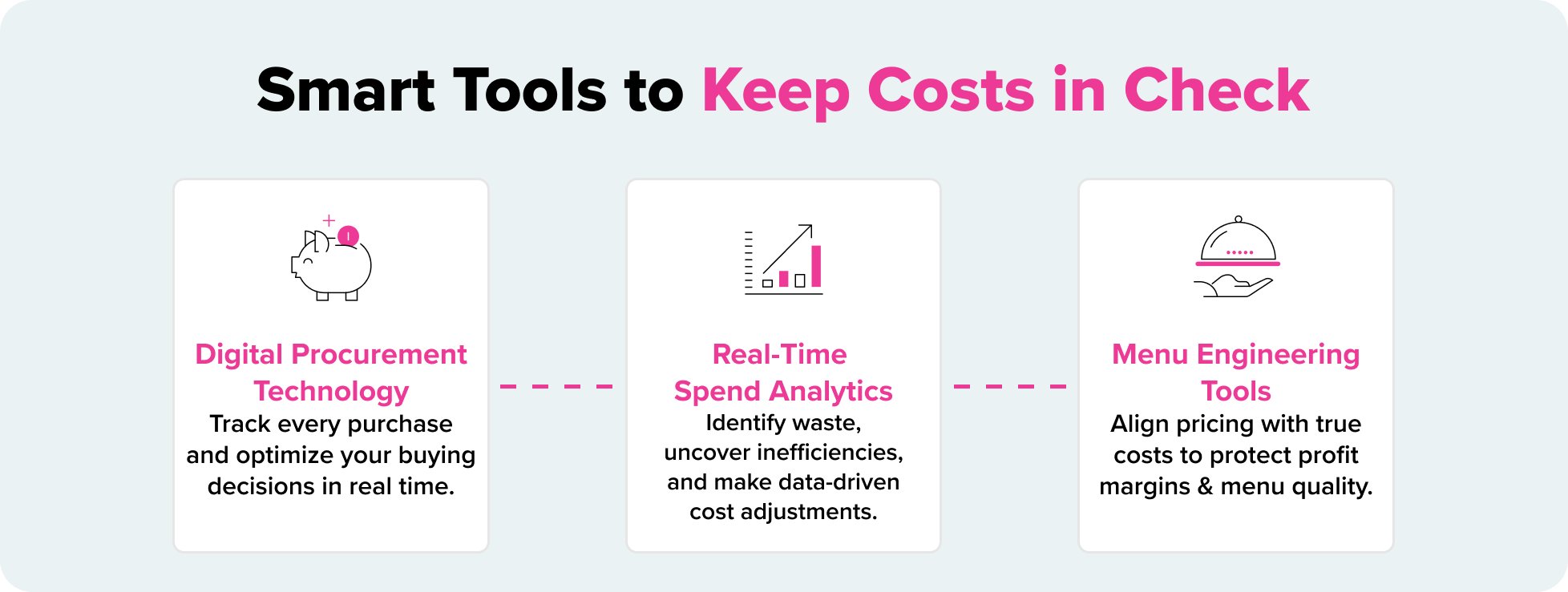There are always problems in the restaurant business. Before the pandemic, profit margins were very small, it was hard to find and keep staff, and consumer trends changed faster than menus could be changed. These pressures haven’t gone away in 2025; they’ve changed.
Many restaurants are on the edge of survival and success because of rising food and labor costs, complicated supply chains, and customers who don’t always act the way they expect. But failure isn’t always going to happen. The first step to making a restaurant profitable in the long run is to understand why they fail and how to deal with these problems before they happen.
Below, we look at ten common reasons why restaurants fail and how the best ones today are using data, technology, and smart buying to stay ahead.

1. Rising Costs Outpace Revenue
Inflation has reshaped foodservice economics. From proteins and produce to rent and utilities, costs are increasing faster than operators can adjust menu prices. Many restaurants fail because they don’t have clear visibility into where their money is going — or how to control it.

This is how successful operators are fighting back:
- Using digital procurement technology to keep track of every purchase
- Using real-time spend analytics to find waste and inefficiencies
- Using menu engineering tools to make sure prices are in line with real costs
These solutions give operators the information they need to keep menu quality and profit margins high.
2. Poor Cost Control and Inefficient Procurement
Many restaurants still use old spreadsheets, take orders by hand, or make deals with suppliers over the phone. They often do the following without data-backed visibility:
- You pay too much for things without knowing it.
- Don’t get rebates or prices that are set by contract.
- Spend time keeping track of orders and bills by hand.
Digital procurement software helps operators automate checking prices, keeping track of rebates, and comparing prices from different suppliers. When every penny counts, the decisions you make about what to buy can mean the difference between making money and losing it.
3. Supply Chain Disruptions and Limited Visibility
The “supply chain adventure” is not over yet. Weather events, changes in global trade, and delays in shipping are still making it hard to get ingredients and change prices. When restaurants don’t plan ahead, they often run out of important items or have to pay extra to get them back.
To make the supply chain more resilient, operators should:
- Work with distributors and experts in the field, like Fresh Concepts and Produce Alliance
- Forecast demand using predictive analytics and historical data
- Adopt software tools that monitor supplier performance and track shipments in real time
These strategies help restaurants keep their brand promise even when things get tough by making things more consistent and safe.
4. Labor Shortages and Retention Challenges
Labor is still one of the main reasons why restaurants close down. Operators are in a “talent tug-of-war,” trying to find a balance between higher wages and the need to hire and keep skilled workers.
Some common labor challenges include:
- There is more competition for skilled workers.
- Because of high turnover, service isn’t always good.
- Teams that have too much to do are getting burned out.
Restaurants that are looking to the future are rethinking how they staff their businesses and spending money on technology and automation to make up for gaps in their operations. Scheduling software, automated inventory systems, and AI-driven forecasting are some of the tools that help teams do more with less by making their jobs easier and keeping them on track.
5. Inconsistent Quality and Customer Experience
In today’s on-demand world, customers expect consistency. One bad meal or delayed delivery can result in lost loyalty and negative reviews that spread quickly online.
Restaurants that succeed are able to focus on keeping things running smoothly by:
- Managing recipes from one place
- Keeping track of supplier quality
- Standardized checklists and training
Buyers Edge Platform software solutions help multi-unit operators bring these efforts together, making sure that every plate meets brand standards at all locations.
6. Lack of Financial Visibility
Many operators don’t have a full picture of their costs — from food and beverage to indirect spend. Without accurate reporting, it’s nearly impossible to make informed decisions about pricing, staffing, or menu design.
Here’s what visibility looks like in action:
- Integrating purchasing data with accounting platforms
- Automating general ledger (GL) coding and exports
- Analyzing spend by category, supplier, and location
Restaurant accounting and spend analytics tools from Buyers Edge Platform’s software division empower operators to connect purchasing data with back-office systems for true transparency.
7. Failure to Adapt to Changing Consumer Preferences
Consumer behavior is always changing, and not being able to keep up can be fatal. People who eat out today care more about their health, the environment, and how easy it is to eat out.
Restaurants that stay relevant:
- Be open about what’s on the menu and use ingredients that are grown or raised in a way that is good for the environment.
- Use digital tools like mobile ordering and loyalty apps.
- Work with Fresh Solutions to make sure your sourcing matches what customers want.
Adapting to these preferences builds brand loyalty and positions restaurants as forward-thinking leaders in their communities.
8. Weak Menu Engineering and Profit Strategy
Many restaurants design menus based on creativity, not profitability. Without analyzing plate costs and contribution margins, operators can unintentionally feature low-margin items that erode profits.
Three steps to smarter menu design:
- Identify bestsellers with high profit margins
- Re-engineer or reprice underperforming dishes
- Use menu engineering technology to visualize the impact of each item
When paired with procurement and pricing data, menu engineering turns your menu into a powerful profit driver.
9. Lack of Data-Driven Decision Making
In a world full of data, trusting your gut is a sure way to fail. Operators who don’t have access to accurate, integrated data often miss chances to:
- Optimize supplier relationships
- Use contracts more effectively
- Find ways to save money early
That’s why top people in the field are using software solutions like ArrowStream, InsideTrack and Back Office from Buyers Edge Platform. These tools bring together data on purchases, prices, and performance from different locations, giving teams the power to make smart, confident decisions that have a direct effect on the bottom line.
10. Not Leveraging Strategic Partnerships
Both independent and multi-unit operators sometimes work in silos, where they negotiate, find suppliers, and solve problems on their own. But to do well in today’s world, you have to work together.
Operators can get the same scale, technology, and insights that big chains usually have through strategic partnerships and group buying networks. The Buyers Edge Platform links restaurants to a huge network of suppliers, distributors, and professionals who can help them:
- Get better pricing and rebates
- Make their supply chain more stable
- Use technology to make things work better
From Risk to Resilience

So, what makes restaurants fail? They often have to deal with complicated problems without the right tools or information to solve them. But there is a way to solve every problem on this list.
Operators can turn vulnerability into resilience by using digital procurement, adopting fresh solutions, leveraging supply chain management, and implementing software solutions that give them visibility and control.
It’s not about avoiding problems in the restaurant business; it’s about outsmarting them. With the right partners, data, and technology, operators can do well in an industry that is more connected, competitive, and innovative than ever before.

